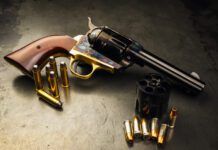It seemssome of the really nice stuff in firearms doesnt last long enough for all good men and women to hear about it, spread the word, and go out and buy it. How many times have we all said, “If only such and such company would make this or that,” only to have it pointed out to us that they used to make this or that, no one bought it, so it was dropped from the lineup. Weve encountered several Taurus firearms on the company website and in local gun stores that looked like really good ideas, only to find out theyd been recently discontinued. The same could probably be said of many gun makers who had a product that fit a niche market, failed to promote it sufficiently, and had to stop production. Such is apparently the case with two of the three guns in this report, though one of those two is still available in a specialized form.
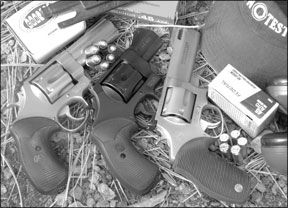
The concept of a revolver chambered for 45 ACP goes back to WWI, when Colt and Smith & Wesson brought out their Model 1917s to fire the semiautomatic-pistol cartridge through the use of half-moon clips. With the more recent introduction of full-moon clips, these six-shot revolvers can be reloaded very quickly as long as you have a supply of loaded clips. The original S&W Model 1917 had a detent to hold the cylinder fully open, which helped expedite the reloading process. Recently, revolver maestro Jerry Miculek proved just how fast a 45 revolver can be reloaded. He fired six shots from his gun, dumped the empties, reloaded, and fired six more-all in less than three seconds.
We acquired three 45 ACP revolvers, an early S&W Model 625 (Model of 1989) with 4-inch barrel (about $900), a new S&W Model 325 Night Guard with nominal 2.5-inch tube (MSRP $1082), and a Taurus Tracker Model 455 SS4 with 4-inch barrel and integral muzzle brake (about $500). The S&W Model 625 is apparently only available today as a Jerry Miculek Special version at $1011, or as a Performance Center gun with 5.2-inch barrel at a higher but unspecified price. You might also find a 3-inch version of the blued Model 25 as a Dealer Special. Still another S&W 45 ACP revolver is the Thunder Ranch Special, with 4-inch tube and flashlight, for $1335. These last two still appear on the company website. Be aware it might not be easy finding a 4-inch or 5-inch S&W 625 like our test gun. A search of 350 S&W revolvers at the Guns International website (gunsinternational.com) found not one Model 625. The neat, efficient five-shot Taurus was recently discontinued, but you can still find samples here and there.
Both the Taurus and S&W 625 had excellent adjustable sights. The Night Guard comes with fixed sights with a tritium insert in the front post. All these revolvers supposedly could be fired with 45 ACP cartridges dropped individually into the chambers, or with full-moon clips, or with 45 Auto Rim cartridges. The two Smiths could also accept the older three-shot, half-moon clips. We tested with Black Hills 230-grain ball, Federal Hi-Shok 185-grain JHP, and Cor-Bon 185-grain JHP. We also tried a few Auto Rim cases handloaded with 260-grain Keith cast bullets, but didnt include them in the formal results. Heres what we found.
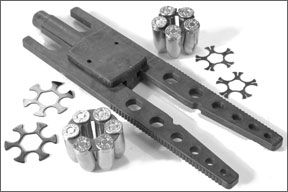
S&W Model 625-3 (Model of 1989) 45 ACP, about $900
The stainless-steel 625 was slick and smooth, and generally wonderful all over. The small, slim Pachmayr grips made the gun pleasant to hold and shoot, and gave easy access to the trigger. The right side of the under-lugged barrel had “45 CAL MODEL OF 1989” electro-etched into its matte-stainless finish. The left side had the company name. The hammer retained the old-style firing pin, though the barrel was not pinned in place. A stubby, well-checkered hammer and a wide, smooth trigger completed the setup. The latch had had its edges rounded by the guns owner. He told us the gun had come with finger-grooved rubber grips that had not fit him at all. He cut the grips down but eventually replaced them with the small ones shown.
The timing, fit, finish, and workmanship were excellent throughout. The lockup was tight, with no slop anywhere. The owner had put a thousand rounds through the gun before we inspected it. The extremely smooth double-action pull had us grinning. Later we were told the gun didnt come that slick. Its internals had been slightly modified by its owner. The SA trigger pull was like ancient S&W revolvers, crisp and clean, breaking at 3.8 pounds. The DA pull was very smooth at 10.3 pounds.
The gun was matte finished everywhere except for the blued, adjustable sights.
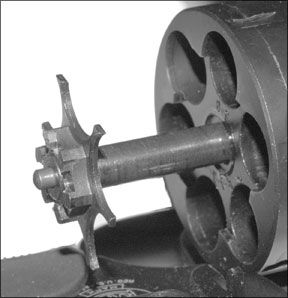
The ramped front-sight insert was serrated to cut glare, and both front and rear were devoid of all dots, glitter, paint, and what-have-you. That was refreshing. We noted this was one of the first modern S&W revolvers to have the correct dimensions to its cylinder outlets. They closely matched the groove diameter of the barrel. Earlier Model 25s commonly had outlets as large as 0.458 inch, much too large for the 0.450-inch to 0.451-inch barrel. This gave leading with cast bullets, less-than-ideal accuracy, and even some spitting with jacketed bullets. Not so this one. All recent Smith 45 revolvers weve checked have the correct dimensions, as do the Night Guard and the Taurus in this test report.
We used the owners trimmed full-moon clips, which were easy to load. The factory ones that came with the Night Guard were so hard to load as to defy our strongest fingers. They need to be “tuned” with a circular file or other suitable tool to make them easy to load, yet tight enough to hold the cartridges firmly. When it was time to remove the empties from the clips, we used a “Demooner,” available for about $17 from Brownells. If you like 45 ACP revolvers and full moon clips, get yourself a Demooner. Trust us, theyre worth it if you value your fingers, time, and serenity.
Rapid-fire results with this gun were the best of the test. The weight and balance of the gun let us get excellent hits as fast as we could work the smooth DA trigger. The 625 was extremely fast to reload. The full-moon clips held the cartridges in firm alignment so the reload was able to drop into the gun easily. This was not the case with the Taurus and its five-shot clips, as youll see. Loose rounds all fired properly. There were no problems with the 625, and its accuracy was outstanding. We thought it was a mighty pleasant handgun.
S&W Model 325 Night Guard 45 ACP, $1082
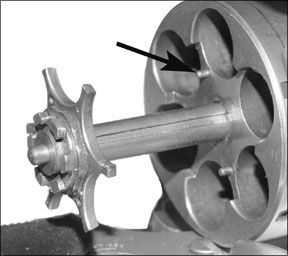
This was an all-matte-black, scandium-frame revolver that from the start not many of us liked, for varying reasons. First, though the gun was lighter than the other two, we could see no good reason for its short 2.8-inch (true length) barrel. It did nothing for concealability, made the gun harder to shoot because of the reduced sight radius, added to the blast with hotter loads, and increased the muzzle flip. A suitable thinner but longer barrel would be the ticket, we thought. It would add greatly to the guns utility and be just as easy to conceal. Next, most of us found it impossible to shoot this gun in double-action mode. The rubber grip was too thick at the back to permit getting a good grip on the trigger with the finger, with the gun held properly.
The guns workmanship overall was excellent. The dull matte finish on the light frame resembled Parkerizing but was much more durable. An exception was the finish on the rear sight, which showed scuff marks as though it was in fact Parkerized. The muzzle area was unblued, which gave the gun an imposing look when viewed from the front. The sights were fixed, with a tritium insert in the front ramp and a U-notch in the blocky rear. Like the 625 the gun would take half- or full-moon clips. It was supposed to be shootable without any clips at all, the rounds headspacing on the front of the chambers. This proved to be not the case, when we took the gun to the range.
The first thing we found was that the rounded top of the Night Guards front sight didnt give us as clear a sight picture as desired. Only with extreme diligence could we hold elevation. Holding windage was not a problem, but all shots landed 2.5 inches left at 15 yards, and there is no way to correct that. Even worse was that all shots landed very low, and theres no easy way to fix that. Hardball was 5 inches low and 2.5 inches left, as was the Cor-Bon load. Federal 185-grain JHP landed 9 inches below point of aim, and again off to the left. A few rounds of
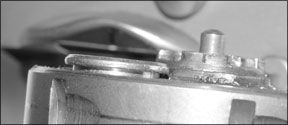
handloaded Auto Rim with 260-grain Keith cast bullets also landed 5 inches low. Group sizes were all significantly larger than those from the other two guns. Felt recoil was not a problem with anything we tried in the Night Guard. The relatively heavy 5-pound single-action trigger pull was crisp enough.
When we tried shooting the gun quickly, we bogged down because of the DA pull. The pull length and over 14-pound pull weight gave us fits. Though the gun had a minimum distance from the hand web to the trigger only a tenth of an inch longer than the 625, that was enough to keep our finger just enough off the trigger (with a proper hold on the gun) to make double-action shooting impossible. We dont have small hands nor weak fingers.
The solution would be to replace the thick rubber grips with a thinner one, or with panels that leave the back strap open, so you can get proper leverage on the stiff DA trigger. As a result of the thick grip and stiff DA pull, we found we could shoot the gun only about half as fast as the 625, and that only by using an incorrect hold on the gun. The guns barrel must line up with the forearm, so recoil goes there and not into the thumb.
We found a huge difference in the star designs of the old versus new S&Ws, and in the length of the ejection strokes. The old one had a stroke of 1.1 inches. The new, only 0.9 inch. Both will get the empties out, but the old one gets them out farther and faster. Of course the shorter barrel may well have dictated the shorter stroke. Far more significant is the new guns elimination of the two guide pins at the rear of the cylinder for the star. The new guns star is, to put it gently, flimsy looking. Its thinner, a full tenth of an inch larger in diameter, and its long, spindly legs extend outward to nestle in extended cutouts in the rear of the cylinder.
We could see no reason for making the star larger, thinner, and less sturdy than before. The new stars legs are 0.047 inch thick. The old stars legs are 0.77 inch thick. We suspect the new ones will get bent by misadventure and result in problems for S&W. We noticed this discrepancy during speed-loading drills when we suddenly found the new guns star interfered with the recoil shield if we were in a
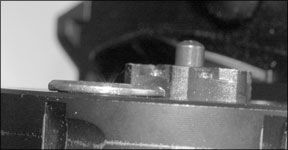
hurry. Naturally the gun cannot be unloaded or reloaded unless the cylinder is fully open, but we didnt like the fact that Smith & Wesson has messed with a proven design that is probably a century old. However, one good feature is that itll be easier to keep the area under the star clean. Dirt there can lead to misfires.
On the range we found the Night Guard had decent accuracy, but not as good as the other two guns. The combination of a stiff trigger, questionable sight picture, and shorter sight radius told the tale. Also, as noted, the fixed sights gave hits anywhere from 5 to 9 inches low at 15 yards. Thats not good. We dropped a few rounds loose into the chambers to see if the gun would reliably fire them. It would not. Rounds from two different manufacturers went so far into the chambers they would not fire. The 625 and Taurus fired all loose rounds all the time. One round in the Night Guard was wedged into the chamber and had to be driven out. This was not quite a total failure of the gun, but not far from it. The gun came with half a dozen full-moon clips, so the company at least gave you a way to fire it. But as noted above, these clips were in desperate need of work to make them easier to use. We think S&W can do better than this.
Taurus Tracker 455SS4 45 ACP, about $500
This five-shot revolver was formerly available with 2-inch, 6.5 inch, or with our test guns 4-inch tube. There was also a lightweight 4-inch version. Our guns barrel was interrupted by an integral muzzle brake that, frankly, we thought was entirely unnecessary on a handgun of this power, especially in light of the heavy underlug adding weight to the front. The formerly available 6.5-inch version had the brake too, but the 2-inch one omitted it as did the 4-inch titanium version that sold for $800. All are recently discontinued, so youll have to do some scrounging if you must have one.
We thought this gun was well worth having, the brake notwithstanding. It came with a matte stainless finish as nice as that on the S&W 625, and it had the
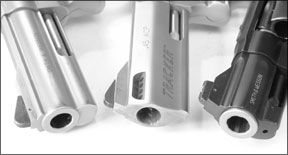
famous Taurus ribbed-rubber grips that add so much to shooting comfort. The sights were an adjustable rear and a red insert on the ramped front. They were blued, and gave an excellent sight picture. The DA pull was useable, smooth, and broke at 10.6 pounds. The SA pull was even lighter than the 625s at 3.6 pounds, and just as crisp and clean. Ignition was via transfer bar. Cylinder lockup was not as tight as on the two Smiths, but not bad. The biggest difference, other than price, was the five-shot capability. Like all recent Taurus handguns, it had a build-in lock that added a sometimes-useful safety feature.
The gun came with three moon-type clips with slim, thin fingers to hold the rounds. We found them to be on the flimsy side, with one “notch” failing to hold anything until we altered it by careful bending. It bent easily. We later found these five-round clips didnt hold the rounds as stiffly as the six-shot moon clips on the S&Ws, which meant super-fast reloads would often not work. Individual rounds could move maybe 15 degrees out of alignment, compared to about 5 degrees for the six-shot moon clips used on the S&Ws. The shaky rounds would catch on the rear of the Trackers cylinder. The Taurus clips need to be thicker and a bit stiffer, we think, to do a better job.
On the range we found the Taurus was a tack driver, at least with the Federal load. It averaged under an inch, best of test. On another group with Cor-Bon, four of the five went into one hole. Undoubtedly the superb trigger helped us get all the gun had to give. We didnt much mind the blast of the muzzle brake, but could have well done without it. About the only thing we noticed is it kept muzzle jump down with the Cor-Bon load, but blast was definitely increased. When we tried the Auto Rim handloads we found they would not go into the Trackers chambers. The chambers were too tight to accept the reloaded cases. New ones would be just fine, of course.
0908-SW-Model-625-3-45-ACP.pdf
0908-SW-Model-325-Night-Guard.pdf



























